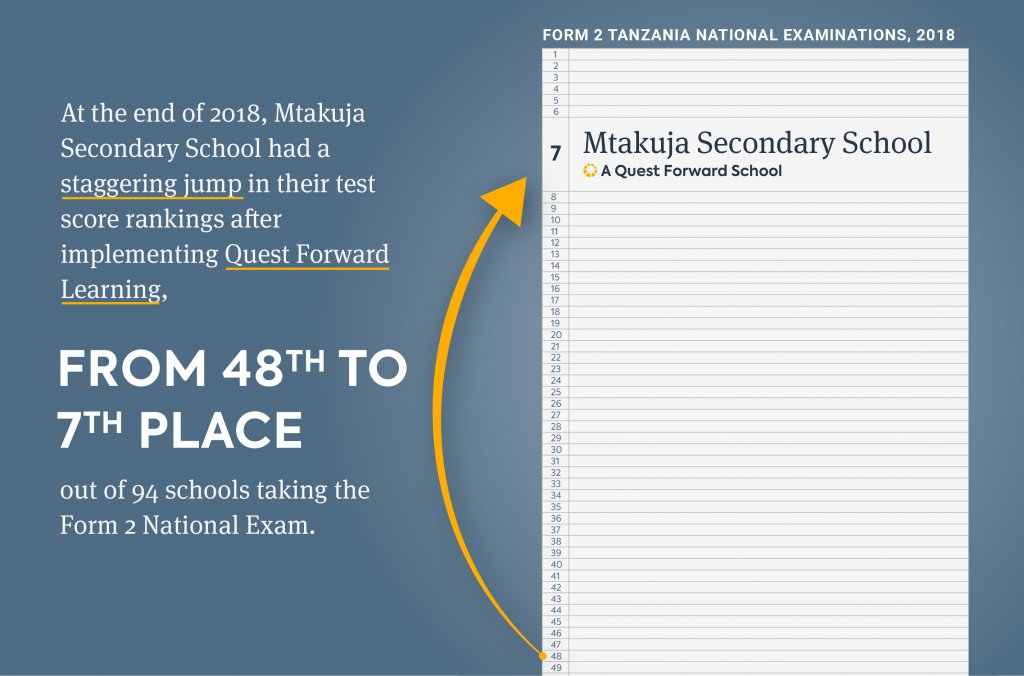What We’ve Learned So Far
While Opportunity Education has been developing Quest Forward Learning for over 4 years, it has been only slightly more than 2 years since the model was deployed on a whole-school basis in Tanzania, and just under 2 years since it was initiated in the US at the Quest Forward Academies. The biggest challenge faced by any educational approach is in showing that it has a measurable impact on students. While it is possible to explain why a certain approach should be better, establishing that such an approach produces better results is a challenge. Unlike pharmaceutical trials, for instance, education does not easily provide opportunities for randomized control testing.
In the short-term, the questions that we need to answer are:
- Are students learning?
- Are they showing growth?
- Are achieving what they are capable of?
In answer to the first question, we can point to evidence from national examinations. In Tanzania, where the Form 2 students at Mtakuja Secondary School took the national examination at the end of the 2018 academic year, the results were quite strong, with students placing 7th out of a field of almost 100 schools, and up from a position for 48th in the prior year. Particularly notable was that almost two-thirds of the students scored in the highest bracket.

Meanwhile, in the United States, performance on the ACT Aspire placed the Quest Forward Academy in Santa Rosa at the 68th percentile nationally and the Academy in Omaha at the 45th percentile, both remarkable results for schools in their first year of operation. Looking at median scores, Academy students are also outperforming students at established charter schools. The accomplishments of our students have been noticed by colleges; the first group of eight students who graduated this June have all been admitted to their first-choice college program.
This type of accomplishment is one possible answer to the question of how effective Quest Forward Learning is, and can become. Such results support the claim that Quest Forward Learning students are, in fact, learning. This is perhaps best and currently defined by several examples of student performance. In Tanzania, the confidence and capabilities of students in Tanzania described in recent blog posts report the changes in learning habits and how students have discovered relevance in their coursework. At the US Quest Forward Academies, the type and creative caliber of work being produced shows a very positive trend.
While test scores provide one context for examining growth, student performance provides another, dramatic illustration of how Quest Forward Academy students develop skills that allow for meaningful engagement with their courses. This type of growth can also be clearly observed by the parents of our students, which is what is most frequently commented upon when comparing Quest Forward Academy experiences to students’ prior schools.
We at Opportunity Education are highly motivated to formulate a way to measure the effectiveness of our methodology for students, without having to rely on external examinations. We are hard at work on developing a formal model of evaluating student efficacy, using their performance in course work and demonstrated competence. Drawing on classroom performance, performance on assignments, and the demonstration of learned skills and concepts, this model will demonstrate that students are on track to achieve goals outside and after their time in school. Once this model is in place, we will be able to assert with confidence that Quest Forward Learning students are achieving at their level of capability.
Longer-term, the questions we hope to answer are:
- Were students successful in college?
- Are they succeeding in their careers?
- Are they making focused, effective decisions in their lives?
- Are they capable of value creators in their communities?
- Are they realizing their dreams?
These later questions are ones that we will only begin to answer in the coming year, as our first graduates arrive at college in the fall. We will be able to fully answer them in another 6–8 years, as a meaningful number of these students finish college and enter the workforce. Until this data is available, we will continue to focus on how to measure growth in order to demonstrate the transformative potential of Quest Forward Learning.
